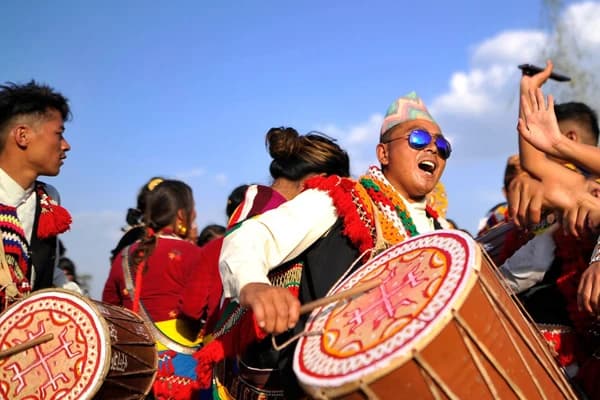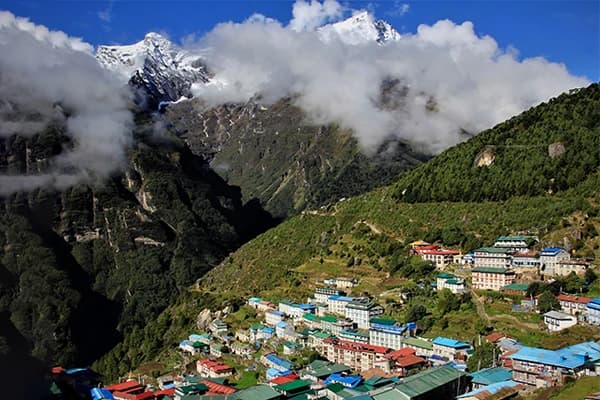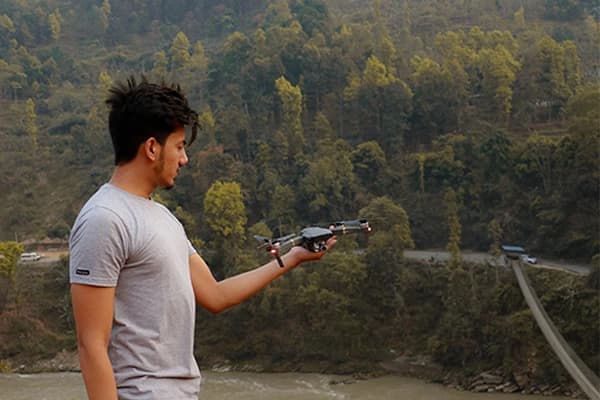Surroundings and Environment of the Camp
The Mardi Himal base camp surroundings are home to several flora and fauna. Over 30 species of the flora, including magnolias, orchids, and primroses, create colorful displays, especially during the spring season. The other seasons also offer floral displays, but they are very rare, and few of the flowers are there.
The upper surroundings of the base camp are mostly alpine meadows dotted with wildflowers. At the camp, hardly any vegetation is adapted to the harsh mountain environment.
In the case of fauna, in the higher elevations near camp, you may spot the elusive mammals like Himalayan tahr (wild goat), musk deer, and snow leopard.
Additionally, you may also find the snow frog and Himalayan salamander up to an elevation of 5,000 meters. The area is also home to several insects like butterflies, moths, beetles, grasshoppers, and crickets.
Many trekkers also visit the Mardi Himal Base Camp for several other reasons, like bird watching. The area is also home to several bird species, including the Himalayan monal (Nepal’s national bird), eagles, vultures, and pheasants. At the mid-elevation near the camp, you may find most of them.
While not in the Mardi Himal base camp, the nearby areas like Forest Camp and others are inhabited by several ethnic communities, including Gurungs and Magars. There you can experience their daily lives, architecture, and celebrations.
The journey to the Mardi Himal base camp is not only about the adventure but also about the cultural interactions. Talking to the locals, listening to their stories, sharing your stories with them, and many more things make the journey more beautiful.
The local cuisines and the hospitality are also great in the area. The nearest stop where you will get to experience the rich hospitality and taste the unique cuisines is High Camp.
Although the permanent residence of the local is none in the high camp, the presence of the local and their dishes makes you feel like you are in the village.
If you are visiting the base camp during the festival time, like during dashain and tihar, you will get to experience the festive environment and taste the festive delicacies.
Scenic Beauty at Base Camp
The scenic beauty at the Mardi Himal base camp is truly beautiful. In fact, it is one of the major highlights of the journey to the camp. From there, you can witness the spectacular views of the mountain peaks like machhapuchhre (Fishtail), Annapurna South, annapurna i, Hiunchuli, and Mardi Himal.
The views can be seen clearly because of the base camp’s position on the ridge. Both sunrise and sunset views can be seen from there. This spot is also popular because it gives the sense of closeness to the popular peaks without the requirement of climbing.
Beyond the mountains, you can also see the views of the landscapes, like alpine meadows, rocky moraines, forested hills, terraced farmlands, and distant valleys. Viewing the 360-degree views of the mountains along with the surrounding landscapes makes the scenic beauty more beautiful.
Trail Details and Accessibility
The starting points of the journey to the Mardi Himal base camp are Kande and Dhampus Phedi. It depends on which itinerary you choose to trek to. Both are popular ways and are accessible from pokhara. It takes around 40 minutes to reach the trailhead by vehicle.
If you are starting your journey from Kathmandu, then you will need to take the flight or the vehicle from Kathmandu to Pokhara. The flight time from Kathmandu to Pokhara is approximately 25 to 30 minutes, while if you take the bus, it will take between 6 and 8 hours.
The flight seems to be convenient, while traveling by bus offers views of the rivers, farmland, forests, valleys, and so on.
Then, from Kande or Dhampus Phedi, you will start your trek to the Mardi Himal base camp.
The trekking experience from the starting point of the trek to the Mardi Himal base camp is thrilling. The difficulty level of the trek is moderate, suitable for beginners and seasoned trekkers. The trails are well marked, and teahouses are available at the different stops on the trail.
The trail gives mixed experiences, as the terrain can be steep at times, and steep ascents and descents may be needed. Physical strength is still needed. If you are traveling during the winter or monsoon season, you may experience hardship with lots of off-season challenges.
However, the views of the snow-capped peaks, lush green scenery, local culture, hospitality, and local interactions make the journey enjoyable and worth going.
The duration of the trek to the Mardi Himal Base Camp is between 7 and 10 days, starting and ending in Kathmandu. The itinerary can be different depending upon your preferences, pace, and additional plans. Here is the general 9-day itinerary. It is the most loved one.
|
Day
|
Activity
|
Duration
|
|
1
|
Trek briefing and preparation in Kathmandu
|
----------- |
|
2
|
Fly/Drive to Pokhara, drive to Kande, trek to Pitam Deurali (2,100m)
|
30 min flight and 4 hours trek
|
|
3
|
Trek Pitam Deurali to Forest Camp (2,500m)
|
7 hours
|
|
4
|
Trek Forest Camp to Badal Danda (2,970m)
|
4 hours
|
|
5
|
Trek Badal Danda to High Camp (3,580m)
|
4 hours
|
|
6
|
Trek to Mardi Himal Base Camp (4,450m) and return to High Camp
|
8 hours
|
|
7
|
Trek High Camp to Siding Village (1,885m)
|
7 hours
|
|
8
|
Drive Siding Village to Pokhara
|
3 hours
|
|
9
|
Fly or drive to Kathmandu
|
30min flight or 6-8 hours drive |
The alternative 7 day itinerary are
|
Day
|
Activity
|
Duration
|
|
1
|
Drive from Kathmandu to Pokhara
|
6-7 hours
|
|
2
|
Drive to Phedi and trek to Pothana
|
about 5 hours
|
|
3
|
Trek from Pothana to Forest Camp
|
around 7-8 hours
|
|
4
|
Trek from Forest Camp to High Camp
|
approximately 6-7 hours
|
|
5
|
Trek to Mardi Himal Base Camp and descend to Siding
|
about 7 hours
|
|
6
|
Drive from Siding to Pokhara
|
2.5-3 hours
|
|
7
|
Drive or fly back from Pokhara to Kathmandu
|
6-7 hours drive or 40 min flight
|
Best Time to Visit Mardi Himal Base Camp
The best time to visit the base camp of the Mardi Himal is during the spring (March to May) and autumn (September to November) seasons. Both seasons have common and unique elements that make those times the best time.
The spring season comes with mild daytime temperatures (10°C to 20°C) and cooler nights (0°C to 10°C at higher altitudes). The weather is pleasant. The flowers bloom, and views of the mountains can be seen clearly.
The autumn season comes with stable weather conditions, shorter days, mild temperatures (10°C to 15°C during the day), less rainfall, and more. The views of the snow-capped peaks can be seen clearly, just like the spring season. The unique element is that the flower doesn't bloom in this season.
Permits required for the visit
The permits required during the visit to the Mardi Himal base camp are the Annapurna Conservation Area Permit (ACAP) and the Trekkers' Information Management System (TIMS) Card. Both permits can be obtained from Nepal Tourism Board offices in Kathmandu or Pokhara.
The documents needed to obtain the permits are a clear photocopy of your valid passport, two recent passport-sized photos, a completed application form, and travel insurance details (optional).
Accommodation and Facilities in Mardi Base Camp
As there are no teahouses exactly in the Mardi Himal base camp. But you can find the teahouses in nearby places like Mardi Himal High Camp, which is just 6 kilometers away from the base camp.
The accommodation options are mostly teahouses run by the local families. It offers basic but cozy lodging with beds, blankets, and meals. The rooms are mostly shared, with two beds per room. During the peak trekking season, the room available may be dormitory-style.
The bathroom facilities are mostly shared; showers (hot) may be limited and may be available only as bucket-style showers with an extra cost. The toilets mostly feature the squat-style toilets near the base camp area.
The solar system is the source of the majority of the electricity supplement. In terms of the wifi facility, there are wifi services available in the high camp too. However, the speed of the wifi may be unreliable.
Final words
Mardi himal base camp offers a rare combination of the peaceful solitude, spectacular himalayan scenery, and authentic cultural encounters. Because of this rare combo, the camp becomes a hidden gem for trekkers seeking a tranquil and enriching himalayan adventure.
Dreaming of quieter trails? Let Mardi be your soul trek — plan with us today.





